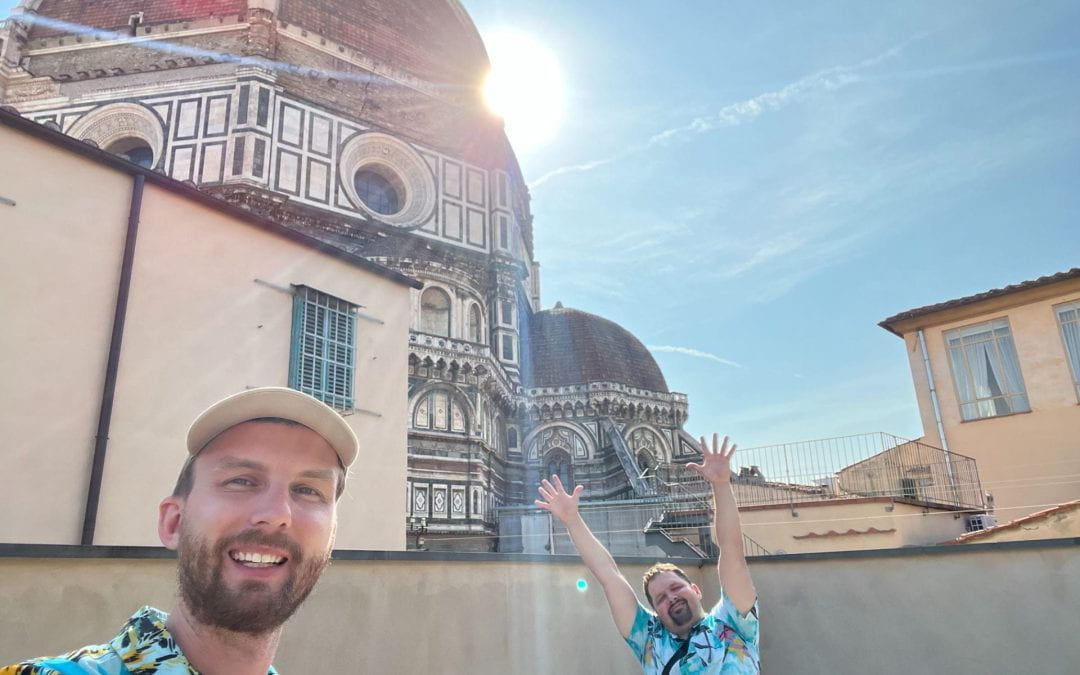Russ Corbett-Detig and Eric Enbody at the Society for Molecular Biology and Evolution in Ferria, Italy, 2023.
By Krizia Chambers
One of the biggest current challenges in genomics research is figuring out how to make vast amounts of genomic data available to the people who need it. At the UC Santa Cruz Genomics Institute, the Corbett-Detig lab is working on ways to share genomic data with scientists, researchers, and public servants so that it is useful and accessible even to those who are untrained in genomic science. They are doing this work through a variety of large-scale projects that range from tracing pathogens with the California Department of Public Health to generating datasets of population variation for California’s wildlife with the California Conservation Genomics Project.
Sharing pathogen data in real-time
As the frequency and severity of infectious disease outbreaks continue to pose significant threats to global health security, the Corbett-Detig lab is leveraging the power of web-based platforms to facilitate real-time data sharing, analysis, and collaboration.
The lab explores the dynamic landscape of viral epidemiology, focusing on collaborative efforts between research laboratories, the California Public Health Department (CDPH), and the Centers for Disease Control and Prevention (CDC) to develop state-of-the-art web platforms and tools to bring genomics to the ground level.
During the COVID-19 pandemic, Yatish Turkahia, then a postdoc in the Corbett-Detig lab and now faculty at UCSD, led the creation of a tree-based data structure, much like the family trees many of us have seen for tracing ancestry, to trace the evolution of COVID-19 in near real-time. To date, their tools have allowed 16 million COVID-19 sequences to be mapped onto a single tree, which is by far the largest display of genomic sequences of a single species ever assembled and breaks new ground for large-data analysis.
The lab’s open-source platform, UShER, has become an invaluable tool that is enabling scientists, policymakers, and healthcare professionals to stay interconnected, exchange critical information, and formulate agile responses to emerging threats. Their platform enabled public health organizations to alert the public to new variants of concern and track new large outbreaks when and where they occur.
“Our research is unique in the fact that we have the opportunity to see an immediate impact,” Corbett-Detig said. “Therefore, there is no time for a delay.”
The Corbett-Detig lab is focused on ensuring genomics is approachable. They teamed up with the UCSC Genome Browser, which has been sharing genomic data with the public for more than 20 years, to make the data they collected as accessible as possible. They also make all their tools open-source on Github so others can make use of their major advances in displaying unprecedented amounts of data. In collaboration with Theo Sanderson at the Crick Institute, the UShER team developed web tools for anyone in the world to explore this comprehensive SARS-CoV-2 family tree. They hope that this will help move the field forward more rapidly.
“Genomics is absolutely going to transform everyday life. It is pretty exciting to be a part of exporting this science to the people,” Corbett-Detig said.
Preserving biodiversity by harnessing the power of conservation genomics
Beyond COVID-19, Corbett-Detig’s lab is also collaborating with the California Conservation Genomics Project, an effort spearheaded by a coalition of scientists, researchers, and conservation practitioners to unravel the intricate genetic tapestry of native species and provide invaluable insights into their adaptation, evolution, and resilience in the face of environmental changes.
Corbett-Detig’s group is uniquely poised to demonstrate the utility of genomic data for the conservation of California wildlife with conservationists, park rangers, biologists, and the general public. At UCSC, this collaboration is led by Genomics Institute postdoctoral researcher Erik Enbody, who envisions anyone being able to leverage the vast datasets that they have collected to learn about California biodiversity and use that knowledge to make decisions that can help protect it.
“Our project aims to leverage advances in genomics to provide a comprehensive understanding of genetic diversity from plants to insects to animals,” Enbody said. “It not only contributes to the preservation of California’s unique biodiversity but also equips conservationists with a powerful toolkit to navigate the complex landscape of ecological management.”
“Presently, the data-collection portion of this project is in its final stages, and the next step is to strategize how to make this data accessible and useful,” Enbody said. “There is already excitement from conservation practitioners.”
A key strength of Corbett-Detig and Enbody’s work with the California Conservation Genomics Project lies in its collaborative ethos, bringing together researchers from diverse disciplines and institutions.
“Genomics has been a long, slow burn, but we are creating tools that can support the large collection of data. We have a speed that is usable almost immediately, which is hard, but what we are good at,” Corbett-Detig said.
This multidisciplinary approach fosters a holistic understanding of the challenges faced by California’s ecosystems and encourages the development of effective, science-based conservation policies. The lab’s earlier successes in making large datasets available to health officials during the pandemic have already proven the transformative potential of these types of initiatives in genomics, and they are looking forward to seeing the impact that genomics will have on California biodiversity as they similarly work to translate their findings to conservationists who can use them.
